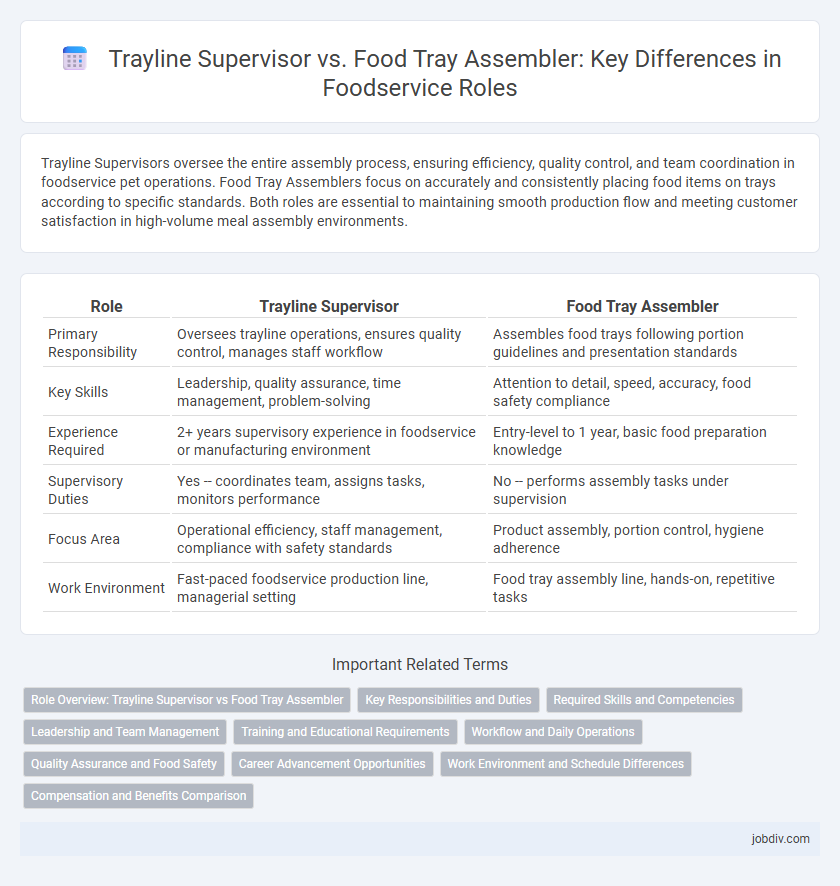Trayline Supervisors oversee the entire assembly process, ensuring efficiency, quality control, and team coordination in foodservice pet operations. Food Tray Assemblers focus on accurately and consistently placing food items on trays according to specific standards. Both roles are essential to maintaining smooth production flow and meeting customer satisfaction in high-volume meal assembly environments.
Table of Comparison
| Role | Trayline Supervisor | Food Tray Assembler |
|---|---|---|
| Primary Responsibility | Oversees trayline operations, ensures quality control, manages staff workflow | Assembles food trays following portion guidelines and presentation standards |
| Key Skills | Leadership, quality assurance, time management, problem-solving | Attention to detail, speed, accuracy, food safety compliance |
| Experience Required | 2+ years supervisory experience in foodservice or manufacturing environment | Entry-level to 1 year, basic food preparation knowledge |
| Supervisory Duties | Yes -- coordinates team, assigns tasks, monitors performance | No -- performs assembly tasks under supervision |
| Focus Area | Operational efficiency, staff management, compliance with safety standards | Product assembly, portion control, hygiene adherence |
| Work Environment | Fast-paced foodservice production line, managerial setting | Food tray assembly line, hands-on, repetitive tasks |
Role Overview: Trayline Supervisor vs Food Tray Assembler
A Trayline Supervisor oversees the efficient operation of the trayline, ensuring timely assembly and quality control of food trays, while managing staff and maintaining compliance with safety standards. A Food Tray Assembler is responsible for accurately assembling food trays according to portion and presentation guidelines, following instructions without supervisory duties. The Trayline Supervisor role demands leadership and coordination skills, contrasting with the Food Tray Assembler's focus on execution and attention to detail.
Key Responsibilities and Duties
Trayline Supervisors oversee food tray assembly operations, ensuring timely, accurate meal production and adherence to safety standards in high-volume foodservice settings. Food Tray Assemblers focus on assembling food trays according to specific menus and portion controls, maintaining quality and hygiene throughout the packaging process. Both roles require coordination with kitchen staff and adherence to sanitation regulations but differ in supervisory versus hands-on assembly responsibilities.
Required Skills and Competencies
Trayline Supervisors must exhibit strong leadership skills, effective communication, and the ability to oversee production workflows, ensuring quality and safety compliance in foodservice operations. Food Tray Assemblers require attention to detail, manual dexterity, and a keen understanding of portion control and presentation standards to assemble trays efficiently. Both roles demand knowledge of food safety regulations, teamwork, and time management, but the supervisor role emphasizes coordination and problem-solving abilities.
Leadership and Team Management
A Trayline Supervisor oversees the coordination and productivity of food tray assemblers, ensuring efficient workflow and adherence to safety standards. Strong leadership skills are essential for managing team schedules, resolving conflicts, and maintaining high morale on the production line. Effective team management involves training assemblers, monitoring performance, and optimizing processes to meet quality and delivery targets in foodservice operations.
Training and Educational Requirements
Trayline Supervisors typically require several years of industry experience combined with training in team management, food safety standards, and quality control practices. Food Tray Assemblers generally need a high school diploma or equivalent, along with on-the-job training to master assembly line processes and food handling protocols. Certifications in food safety, such as ServSafe, are advantageous for both roles but often mandatory for supervisory positions.
Workflow and Daily Operations
Trayline Supervisors oversee workflow efficiency by coordinating food tray assemblers, ensuring timely completion and quality standards during meal production. Food Tray Assemblers execute daily operations by assembling ingredients and packaging trays according to set menus and portion controls. Both roles collaborate closely to maintain smooth trayline processes and meet service deadlines in a high-volume foodservice environment.
Quality Assurance and Food Safety
Trayline Supervisors oversee quality assurance by ensuring food trays meet strict safety and presentation standards before distribution, implementing HACCP protocols, and conducting regular inspections. Food Tray Assemblers focus on accurate portioning, ingredient placement, and adherence to sanitation guidelines during assembly to maintain food safety and consistency. Both roles are critical to preventing contamination and ensuring compliance with FDA and USDA regulations in the foodservice industry.
Career Advancement Opportunities
Trayline Supervisors typically have greater career advancement opportunities than Food Tray Assemblers due to their leadership responsibilities and oversight of production processes. Supervisory roles develop skills in team management, quality control, and workflow optimization, which can lead to higher positions such as Operations Manager or Production Coordinator in foodservice. Food Tray Assemblers often advance by gaining experience and moving into supervisory roles like Trayline Supervisor, expanding their career potential within the food production industry.
Work Environment and Schedule Differences
Trayline Supervisors typically manage fast-paced production lines in large-scale foodservice operations, overseeing workflow and quality control during standard daytime or rotating shifts. Food Tray Assemblers often work in repetitive, stationary environments such as hospitals or cafeterias, with consistent schedules primarily during daytime hours. Supervisors may experience more variable hours and pressure due to managerial responsibilities, whereas assemblers usually have more routine and predictable work patterns.
Compensation and Benefits Comparison
Trayline Supervisors in foodservice typically earn higher wages than Food Tray Assemblers due to greater responsibilities including overseeing assembly line operations and managing quality control. Compensation packages for Trayline Supervisors often include supervisory bonuses, health benefits, and paid time off, whereas Food Tray Assemblers commonly receive hourly wages with limited or no performance bonuses. Benefits for Trayline Supervisors generally feature enhanced healthcare options and retirement plans, reflecting their leadership role within the foodservice production environment.
Trayline Supervisor vs Food Tray Assembler Infographic

 jobdiv.com
jobdiv.com